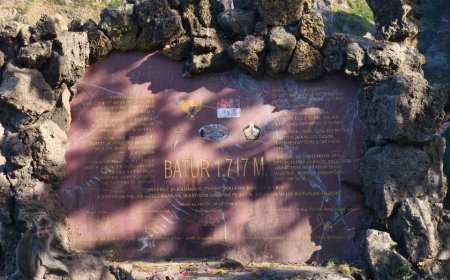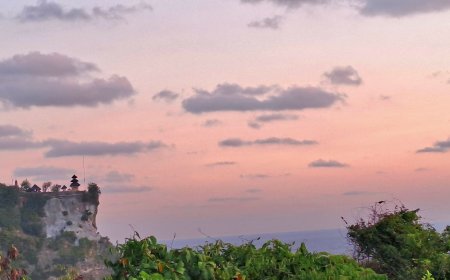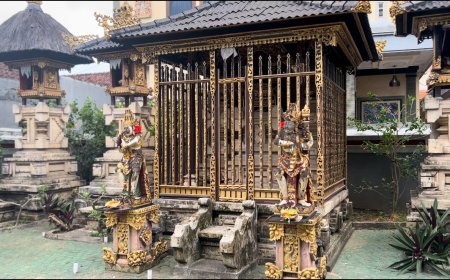Getting to Know Pura Dalem Oongan: An Ancestral Family Temple
Temple or Pura is a sacred place for Hindu religion to pray, each Pura has its own history. Besides their intriguing histories, the structures and ornaments in the Temple also hold their own meanings. Each Temple also has its own types, for example, Dalem Saba Oongan Temple.

The temple (Pura) is the place where the gods reside, where Dalem Temple is the palace of Lord Shiva with the power of fusion. Dalem Temple generally comes in two types: those that are part of the Kahyangan Tiga and those that are not. Dalem Temple that is not related to the Kahyangan Tiga usually has a connection to the history of a ruler from the past. Specifically, for Dalem Temple that is related to the Three Kahyangan, this temple is often closely associated with Setra or a graveyard. Setra(graveyard) is a place used for performing rituals involving Rangda and Barong, including pangliakan, as this liak or leak tradition derives its power from Lord Shiva and Goddess Durga merging into one. Dalem Saba Oongan Temple is one of the temples that is not part of the Three Kahyangan. Although it is located near a Setra or graveyard, this temple does not have a history related to rulers from the past. Instead, it belongs to the category of Dadia Temple (Family Temple). Dalem Saba Oongan Temple has been passed down through generations within a family residing in Denpasar Regency. The caretaker of this temple is Jro Mangku Saba, and it has been an ancestral heritage for a long time.
Dalem Saba Oongan Temple is one of the places for Hindus to engage in positive spiritual activities, especially those related to physical and mental strength. Hinduism is a deeply spiritual religion, and Hindu practitioners typically perform spiritual activities in sanctified places through rituals. Temple is a Sanskrit word meaning a fort connected to a kingdom. In modern times, Temple is not referred to as a fort but rather as a place of worship, especially in Bali. The term for a fort-related work is usually "puri." Bali is home to numerous Temples scattered across the island, and it's even known as the "Island of a Thousand Temples."
Dalem Saba Oongan Temple is a Temple that has been passed down through generations by the family managing it. From ancestors to descendants in the present day, this Temple still stands strong because each generation has preserved its integrity and beauty. In 2022, the Dalem Saba Oongan Temple underwent renovations to enhance or beautify the shrines inside the Temple, using black stones commonly used for carving or shaping according to the previous shrine designs.
Before renovating the shrine and the entire Temple, a ceremony was held to relocate the shrines to a suitable place so that prayers and offerings could continue during the renovation. As the renovation progressed, family members could continue with their offerings as usual because the shrines had been relocated to a suitable place to receive offerings. After the shrine renovation, a ceremony called mlaspas was performed for the completed building or the sanctified structure that had gone through the mecaru phase. In this phase, the building materials were no longer referred to as black stones they became part of the shrine structure.
Dalem Saba Temple also has an odalan date, which is essentially the anniversary of the sacred place's establishment. This is a mandatory event for Hindus because Odalan is a religious ceremony dedicated to the Supreme God, where Hindus demonstrate their devotion to Ida Sang Hyang Widhi within a Temple or sacred place. Furthermore, the odalan ceremony is an obligation for Hindus as it serves as a form of karma repayment to the family or village, an act of gratitude towards Ida Sang Hyang Widhi Wasa, and all of its manifestations. Typically, piodalan or odalan is celebrated annually according to the Balinese calendar. Interestingly, Dalem Saba Oongan Temple is situated within Dalem Oongan Temple, with the two Temple existing side by side.

Padmasana Dalem Saba Temple(Photo Source: Personal Collection)
In addition to having different types of Temple, including those associated with the Kahyangan Tiga (Three Divine Temples) and those not, Dalem Saba Oongan Temple also features several types of shrines used for worshiping the gods and goddesses who reside in the Temple. Each shrine has its own meaning and power, and in this Temple, there is a shrine called Padma or Padmasana, where the gods and goddesses reside. Padmasana represents Ida Sang Hyang Widhi as the universe (Buana Agung). Padmasana is a place for prayer and offerings made by Hindus to the gods and goddesses who reside in the Padmasana shrine. The Padmasana structure consists of a firm base called tepas, a body or batur, and a head called sari. At the base, there are carvings in the form of Bedawang Nala (a turtle) coiled by Naga Anantaboga and Naga Basuki.

Gedong Ratu Gede Dalem Saba(Photo Source: Personal Collection)
After that, Dalem Saba Temple also has a building called Gedong Ratu Gede Dalem Saba, which is situated in the middle of the eastern part and faces eastward within Dalem Saba Temple. The Gedong Ratu Gede serves as the residence of Ratu Gede Dalem Saba, and within this building lies the source of the accumulated power within the Temple.

Gedong Ibu(Photo Source: Personal Collection)
On the southern side of the Gedong Ratu Gede Dalem Saba building, there is another structure called the Gedong Ibu. Inside this building, there are three shrines, symbolizing a balance of spiritual power both outside and inside the Temple.

Tajuk telu(Photo Source: Personal Collection)
In the middle, located in front of Padma, Gedong Ratu Gede, and Gedong Ibu, there are three structures. These structures are called Tajuk Ibu, which is positioned in front of Gedong Ibu but not exactly in front of it. Tajuk Gedong Ratu Gede located in front of Gedong Ratu Gedeand Tajuk Pemayun situated in front of Tajuk Ibu and facing south. The purpose of these three Tajuk structures is to place offerings and offerings dedicated to the deities who reside in the Temple.






























































